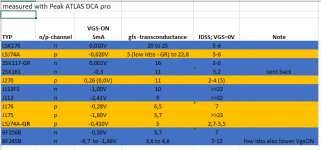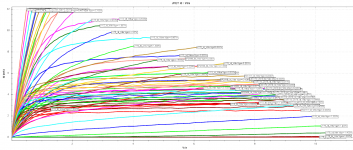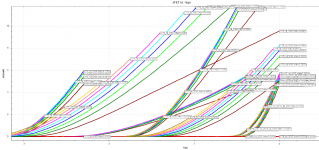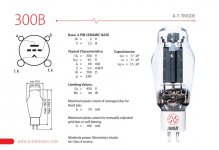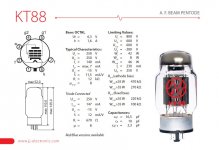The one thing I find remarkable is the consistency of the manufacturing process achieving a spread of 10% on Idss, and 3% on Yfs. Getting matched pairs should be a piece of cake.
I just looked at my stash of J175 originals by NS from half a century ago, and the spread is 15mA to 35mA on Idss.
I also agreed the noise aspect is important. Sadly, I don't have anything handy to measure it; maybe I should rig up something. But then again, I'm under no pressure: for low level purpose, I'm fortunate enough to have a few big guns like the 2SK146 🙂
I just looked at my stash of J175 originals by NS from half a century ago, and the spread is 15mA to 35mA on Idss.
I also agreed the noise aspect is important. Sadly, I don't have anything handy to measure it; maybe I should rig up something. But then again, I'm under no pressure: for low level purpose, I'm fortunate enough to have a few big guns like the 2SK146 🙂
i want to share my small experience with some selections and measurements with JFET´s -this are average datas
got some droubles with 2sk161(think -ESD failures) but expect new one this week.
hopefully after end of may a have time enough to go deeper inside......
meaning i want to try some IPS boards like the different version in the project M2X with a lot of different JFETs on Input power stage boards.
have a nice day - Harry
got some droubles with 2sk161(think -ESD failures) but expect new one this week.
hopefully after end of may a have time enough to go deeper inside......
meaning i want to try some IPS boards like the different version in the project M2X with a lot of different JFETs on Input power stage boards.
have a nice day - Harry
Attachments
Last edited:
I think that today the best matched lownoise jfet pair is JFE2140Toshiba and LS jfets are being matched and I think you will see an announcement in the store shortly.
But isn't the issue here finding matched pairs of P and N types? Is that the same thing?I think that today the best matched lownoise jfet pair is JFE2140
The Idss of JFE2140's is +/- 0.1mA.But isn't the issue here finding matched pairs of P and N types? Is that the same thing?
If you want to know how to live without low-noise P-Channel jfets, suggest reading Bob Cordell's "Designing Audio Power Amplifiers" -- he has a dozen of examples of circuits with N-Channel only.
I can't help myself, so gonna drop a reply and in so doing also help others who are looking for a lower cost alternative to the SK170-SJ74 combo. I am working on a pre- and power amplifier and would like to have alternatives to the Tosh and LS parts. One can always design such that the board can accept both SOT-23-3 and TO92, but back to the question of equivalent or "good enough" replacement parts that are in production.
I found a website a while ago which performed noise tests on FETs, diodes etc. So lets compare the P-channel "underdog" mentioned a few times in the thread, namely the Onsemi J175-177. Just a heads up hear, the J177 is no longer being produced, but would otherwise be interesting to compare with. So we are left with the J175 and J176 which is the TO92 part, while MMBFJ175 / MMBFJ176 is the SOT-23 variant.
First, lets look at the noise picture of the parts.
I found a website a while ago which performed noise tests on FETs, diodes etc. So lets compare the P-channel "underdog" mentioned a few times in the thread, namely the Onsemi J175-177. Just a heads up hear, the J177 is no longer being produced, but would otherwise be interesting to compare with. So we are left with the J175 and J176 which is the TO92 part, while MMBFJ175 / MMBFJ176 is the SOT-23 variant.
First, lets look at the noise picture of the parts.
- Spectral noise density of 2SJ74BL JFET with different Ids values -

- Spectral noise density of J175 JFET with different Ids values -

- Spectral noise density of J176 JFET with different Ids values -

What immediately strikes me is the difference between 175 and 176 and the later is far better and more similar SJ74 in its character, albeit with a higher noise floor than SJ74. Since we have data for an Idss of 8mA, this is what we will compare.
Average >100Hz: The SJ74 looks to be at 0.6-0.7 nV/Hz while the J176 sits comfortable at 1.7-1.8 nV/Hz. Maybe not a disaster, but notably higher. But there is a "fix" to the J176 noise and that is paralleling several devices and up to 4 pcs. I f we do so, the noise is halved from 1.7-1.8 nV/Hz to 0.85-0.9 nV/Hz .. while you ponder that, here something else to take into consideration.
While the Tosh and LS parts demand $10-12 per part, the J176 (TO92) demands some ca $0.30 per device and the MMBFJ176 demand some $0.35. If we play with the idea of paralleling x4 and without matching, we would be at $1.2-1.4 at same or similar noise floor.
Something else to consider between the SJ74 and J176 is:
Part - Ciss - Crss - Gfss
SJ74 - 105pF - 32pF - 8-22mS
J176 - 8pF - 3.5pF - 5-8mS
The span of Vgs(off) is 1-4V and Idss is -2-25mA, so equivalents to the SJ74BL exist.
But wait, there is more.... Regarding the N-chn part, we can add the Toshiba 2SK209 and Onsemi NSVJ3910SB3 to the list, because..Average >100Hz: The SJ74 looks to be at 0.6-0.7 nV/Hz while the J176 sits comfortable at 1.7-1.8 nV/Hz. Maybe not a disaster, but notably higher. But there is a "fix" to the J176 noise and that is paralleling several devices and up to 4 pcs. I f we do so, the noise is halved from 1.7-1.8 nV/Hz to 0.85-0.9 nV/Hz .. while you ponder that, here something else to take into consideration.
While the Tosh and LS parts demand $10-12 per part, the J176 (TO92) demands some ca $0.30 per device and the MMBFJ176 demand some $0.35. If we play with the idea of paralleling x4 and without matching, we would be at $1.2-1.4 at same or similar noise floor.
Something else to consider between the SJ74 and J176 is:
Part - Ciss - Crss - Gfss
SJ74 - 105pF - 32pF - 8-22mS
J176 - 8pF - 3.5pF - 5-8mS
The span of Vgs(off) is 1-4V and Idss is -2-25mA, so equivalents to the SJ74BL exist.
- Spectral noise density of lowest measured noise JFET’s -

Pay attention to the purple graph of 2SK170 compared to the red graph of the NSVJ3910, they are a match. The later is a Vds 25V part. The black graph of the 2SK2394 part is only Vds 15V. The 2SK209 should be very similar in terms of noise and are used and liked by many.
Part - Ciss - Crss - Gfss - $
170 - 20-30pF - 5-6pF - 10-20mS .... $10-12 part
209 - 13pF - 3pF - 4-15mS .... $0.40 or better
3910 - 6pF - 2.3pF - 30-40mS ... $0.50 part
Regarding Idss, the 3910 sits between 20-40mA and the Vgs(off) is -1.2-1.8V while the 209BL part Idss sits around 6-14mA and Vgs(off) is around -1.5V.
OBS: Both parts are SOT-23 only
Summery.
Thanks for this!! 🙂I can't help myself, so gonna drop a reply and in so doing also help others who are looking for a lower cost alternative to the SK170-SJ74 combo. I am working on a pre- and power amplifier and would like to have alternatives to the Tosh and LS parts. One can always design such that the board can accept both SOT-23-3 and TO92, but back to the question of equivalent or "good enough" replacement parts that are in production.But wait, there is more.... Regarding the N-chn part, we can add the Toshiba 2SK209 and Onsemi NSVJ3910SB3 to the list, because..
I found a website a while ago which performed noise tests on FETs, diodes etc. So lets compare the P-channel "underdog" mentioned a few times in the thread, namely the Onsemi J175-177. Just a heads up hear, the J177 is no longer being produced, but would otherwise be interesting to compare with. So we are left with the J175 and J176 which is the TO92 part, while MMBFJ175 / MMBFJ176 is the SOT-23 variant.
First, lets look at the noise picture of the parts.
What immediately strikes me is the difference between 175 and 176 and the later is far better and more similar SJ74 in its character, albeit with a higher noise floor than SJ74. Since we have data for an Idss of 8mA, this is what we will compare.
Average >100Hz: The SJ74 looks to be at 0.6-0.7 nV/Hz while the J176 sits comfortable at 1.7-1.8 nV/Hz. Maybe not a disaster, but notably higher. But there is a "fix" to the J176 noise and that is paralleling several devices and up to 4 pcs. I f we do so, the noise is halved from 1.7-1.8 nV/Hz to 0.85-0.9 nV/Hz .. while you ponder that, here something else to take into consideration.
While the Tosh and LS parts demand $10-12 per part, the J176 (TO92) demands some ca $0.30 per device and the MMBFJ176 demand some $0.35. If we play with the idea of paralleling x4 and without matching, we would be at $1.2-1.4 at same or similar noise floor.
Something else to consider between the SJ74 and J176 is:
Part - Ciss - Crss - Gfss
SJ74 - 105pF - 32pF - 8-22mS
J176 - 8pF - 3.5pF - 5-8mS
The span of Vgs(off) is 1-4V and Idss is -2-25mA, so equivalents to the SJ74BL exist.
Pay attention to the purple graph of 2SK170 compared to the red graph of the NSVJ3910, they are a match. The later is a Vds 25V part. The black graph of the 2SK2394 part is only Vds 15V. The 2SK209 should be very similar in terms of noise and are used and liked by many.
Part - Ciss - Crss - Gfss - $
170 - 20-30pF - 5-6pF - 10-20mS .... $10-12 part
209 - 13pF - 3pF - 4-15mS .... $0.40 or better
3910 - 6pF - 2.3pF - 30-40mS ... $0.50 part
After going over the various data presented here and taking into consideration the overall performance vs cost figure, I feel very comfortable basing a project on the 2SK209 and MMBFJ176. With some paralleling, clever biasing and current source, using these two devices as a starting point should yield some very nice results. Ofc, all of this is theory, so testing is on order.... As a bonus, these parts have triode like capacitance values... 🙂
Regarding Idss, the 3910 sits between 20-40mA and the Vgs(off) is -1.2-1.8V while the 209BL part Idss sits around 6-14mA and Vgs(off) is around -1.5V.
OBS: Both parts are SOT-23 only
Summery.
Summery.
After going over the various data presented here and taking into consideration the overall performance vs cost figure, I feel very comfortable basing a project on the 2SK209and MMBFJ176. With some paralleling, clever biasing and current source, using these two devices as a starting point should yield some very nice results. Ofc, all of this is theory, so testing is on order.... As a bonus, these parts have triode like capacitance values... 🙂
Can you please show us how complementary these suggested devices are (just a simple transfer function plot)?
Also, I'm a bit curious what defines: 'triode like capacitance values'?
The 'some paralleling, clever biasing and current source' may well defeat your 'overall performance vs cost figure', but please do show us how you can achieve this 🙂
2SK2394 noise from 5Hz to 300Hz looks interesting.The black graph of the 2SK2394 part is only Vds 15V.
BF862 noise from 400Hz and above looks superior to anything else. (Too bad it's not in production.)
I wonder if "AM tuner RF amlifier" application FETs is the place to search for yet unfound new gems.
1. go look in the datasheet, a bit of a challenge since the graphs are in different scales.Can you please show us how complementary these suggested devices are (just a simple transfer function plot)?
Also, I'm a bit curious what defines: 'triode like capacitance values'?
The 'some paralleling, clever biasing and current source' may well defeat your 'overall performance vs cost figure', but please do show us how you can achieve this 🙂
2. Triode like capacitance: This one is related to Miller Capacitance and its effects on micro details, resolution and clarity. Miller C exist between the grid-to-plate or anode (triode) and drain-to-gate (Jfet). For the Jfet its the reverse transfer capacitance value. So lets compare.
300B: 7.5pF (Cg-a value)
KT88: 2.3pF (same)
SK170: 5-6pF (Crss value).
SK209: 3pF (Crss value)
First thing first. Triodes are considered the better amplification device compared to MOSFETS and some of the answer is found in the much higher Miller C values which often reach hundreds of pF for FETs and bipolars. If you can hear a difference between a triode and pentode with such small capacitance differences, then what chance does a FET have in comparison. So the difference we see between N-chn parts can have a larger influence than one might think.
3. Not necessarily. If CCS is part of the circuit function compared to just resistors, regardless, then that cost is absorbed anyway. CCS can be designed for less than $10. If we take the basic complimentary discrete JFET differential amplifier and upgrade with some paralleling, active CCS and throw in some DC-servo, I'll bet you that the sum of all those parts are less or equal to those Tosh/LS 4 pcs FETs and some resistors ... that is how expensive they are.
So with the tricks mentioned, the improved circuit will sound better, I am convinced.
https://www.aikenamps.com/index.php/what-is-miller-capacitance
https://audioxpress.com/article/JFETs-The-New-Frontier-Part-1
Attachments
Pairing 2SK209 with MMBF176 sound like a new idea ?
There is a noise plot in the J176 datasheet from Onsemi, which I believe.
~10x that of 2SJ74 at 1kHz.
And I wonder if you have compare the Yfs of J176 to 2SK209 at the same Id ?
Again if I read datasheet correctly, J176 has ~6mS at 6mA, and 2SK209 ~20mS ?
How about dissipation ?
Let's say typically 15V rails in a complementary circuit.
2SK209BL average Idss 10mA, giving 150mW dissipation.
That is the absolute maximum rating in datasheet.
I normally do not use more than 1/3 or 1/4 of that.
Oh, and J176 Idss specified at 2~25mA. Quite a range.
🙂
Patrick
There is a noise plot in the J176 datasheet from Onsemi, which I believe.
~10x that of 2SJ74 at 1kHz.
And I wonder if you have compare the Yfs of J176 to 2SK209 at the same Id ?
Again if I read datasheet correctly, J176 has ~6mS at 6mA, and 2SK209 ~20mS ?
How about dissipation ?
Let's say typically 15V rails in a complementary circuit.
2SK209BL average Idss 10mA, giving 150mW dissipation.
That is the absolute maximum rating in datasheet.
I normally do not use more than 1/3 or 1/4 of that.
Oh, and J176 Idss specified at 2~25mA. Quite a range.
🙂
Patrick
Last edited:
Which is great for Zen... 🙂
The take away from all of this is that if you are working with differential, you can use 2SK209, 2SK2394 and NSVJ3910 as alternative to SK170. If you are working with complimentary differential, you need SK170/SJ74. A local supplier is selling LS parts for $7 and $5, but that is unmatched. The diya store alternative is far better even If I have to pay VAT and shipping.
The take away from all of this is that if you are working with differential, you can use 2SK209, 2SK2394 and NSVJ3910 as alternative to SK170. If you are working with complimentary differential, you need SK170/SJ74. A local supplier is selling LS parts for $7 and $5, but that is unmatched. The diya store alternative is far better even If I have to pay VAT and shipping.
Solution: opamps. Excellent JFETs in those. Chances are that the source already has opamps in it so what is the problem and why still build discrete when discrete parts are becoming hard to find (or cost a multiple of recent parts)?
Solution 2: no preamp/buffer at all but source/volume control to a power amplifier of sorts.
It may be a logical choice to some to use parts that are obsolete for decades but let's say we can be glad it does not work like that with cars and household stuff.
Solution 2: no preamp/buffer at all but source/volume control to a power amplifier of sorts.
It may be a logical choice to some to use parts that are obsolete for decades but let's say we can be glad it does not work like that with cars and household stuff.
2SK2394 and NSVJ3910
Both have low Vds rating and high Idss and hence limited applications.
Moreover, they are very prone to oscillations, even with gate stoppers, and especially when cascoded.
2SK209 as substitute has already been published 4 years ago, but it should be GR grade and not BL :
https://www.diyaudio.com/community/threads/njfets-for-source-follower-applications.329131/
LSK170/LSJ74 Idss is VERY sensitive to Vds and can only be matched at one specific voltage.
No surprise why not being offered at DIYA store, only Toshiba complementaries.
https://www.diyaudio.com/community/threads/replacement-for-toshiba-2sk170-2sj74.317563/post-6578095
https://www.diyaudio.com/community/...lsk170-jfet-pairs-grade-b.321649/post-7035859
Cheers,
Patrick
Opamps ?
Too boring for me.
No thanks.
Want to use active parts only ?
You can buy those TI super JFETs.
Cheers,
Patrick
Too boring for me.
No thanks.
Want to use active parts only ?
You can buy those TI super JFETs.
Cheers,
Patrick
Yeah those things that are in almost every source you have. Boring but working. Available. Cheap. Well performing. Good sounding.
Designing with parts that are obsolete for decades is boring to me. Often a handful of generic parts and the actives only to be found on dubious websites in the Far East or Ebay/Aliexpress with a high chance of getting exactly the desired assumed superparts to be relabeled ones.
Only the one that sits on a stockpile of such parts is happy to design new devices with that parts. In my personal view published DIY designs for others to reproduce at home should be done with parts that can be found at normal distributors, not with parts that are almost impossible to find. Exactly that reasoning is done when such simple designs are coupled to a ready made SMPS. "Easy to find". There is at least some incongruence in that.
For clarity: I have a few devices with these JFETs and some devices that don't have them. I can interchange them at will and mostly use the devices without the discrete JFETs hence my reasoning. The world does not depend on 2SK170/2SJ74.
Designing with parts that are obsolete for decades is boring to me. Often a handful of generic parts and the actives only to be found on dubious websites in the Far East or Ebay/Aliexpress with a high chance of getting exactly the desired assumed superparts to be relabeled ones.
Only the one that sits on a stockpile of such parts is happy to design new devices with that parts. In my personal view published DIY designs for others to reproduce at home should be done with parts that can be found at normal distributors, not with parts that are almost impossible to find. Exactly that reasoning is done when such simple designs are coupled to a ready made SMPS. "Easy to find". There is at least some incongruence in that.
For clarity: I have a few devices with these JFETs and some devices that don't have them. I can interchange them at will and mostly use the devices without the discrete JFETs hence my reasoning. The world does not depend on 2SK170/2SJ74.
Last edited:
- Home
- Amplifiers
- Pass Labs
- Replacement For Toshiba 2SK170/2SJ74
